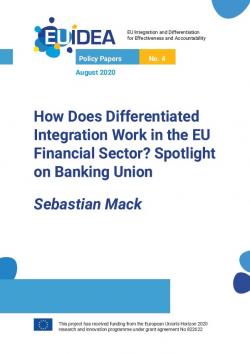How Does Differentiated Integration Work in the EU Financial Sector? Spotlight on Banking Union
Five years after the entry into force of the Banking Union, this Policy Paper assesses its effectiveness as a form of differentiated integration. This case study presents the legal and organisational dimensions of the Banking Union and describes its accountability mechanisms and procedures. At the heart is the question of whether the creation of the Banking Union has been effective in promoting integration among its members while avoiding distortions in the Single Market. To this end, also the impact of the Banking Union on the political unity in the European Union is analysed. This Policy Paper finds that the Banking Union has enhanced European integration in the financial sector without jeopardising the functioning of the internal market. Although the Banking Union is still incomplete, the benefits of participation create centripetal forces that are attractive also to non-euro countries.
-
Details
Rome, IAI, August 2020, 22 p. -
In:
-
Issue
Policy Paper 4
Executive summary
Introduction
1. The case for creating the Banking Union
2. Legal and organisational dimension of differentiated integration through the Banking Union
2.1 The three pillars of the Banking Union
2.2 The Banking Union within the Single Market
2.2.1 Single Rulebook for EU financial regulation
2.2.2 European System of Financial Supervisors
2.2.3 Third-country dimension
3. Accountability mechanisms and procedures in the Banking Union
4. Effectiveness: Problem-solving capacity of the Banking Union
4.1 Banking supervision
4.2 Bank crisis management
4.3 Comparison with “ideal solution” benchmark
5. Impact on European Union’s political unity
5.1 Legal safeguards addressing disintegration risks for non-participating member states
5.2 Legal provisions putting all participating member states on equal footing
5.3 Centripetal forces attracting non-participating member states to join
5.4 Centrifugal forces said to discourage non-participating member states from joining
5.5 Practical considerations of selected countries not (yet) participating
Conclusion
References



